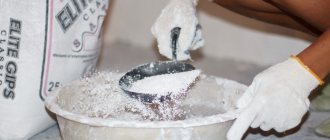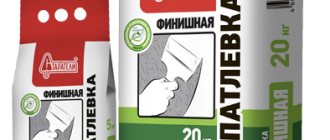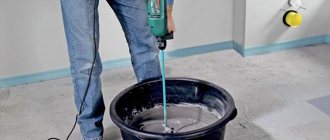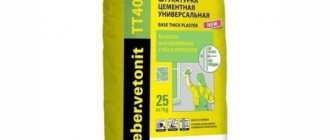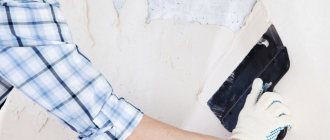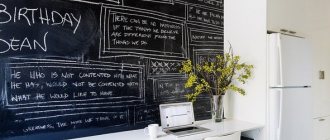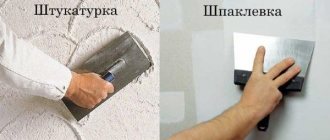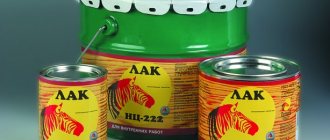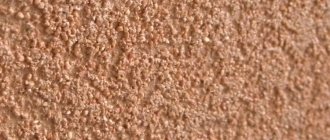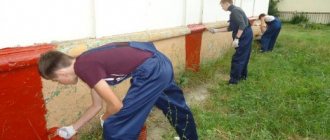Andrey
4649 0 0
Andrey June 20, 2017 Specialization: facade finishing, interior finishing, construction of dachas, garages. Experience of an amateur gardener and gardener. We also have experience in repairing cars and motorcycles. Hobbies: playing the guitar and many other things that I don’t have time for :)
What are dry putty mixtures, what types are there and for what purposes are they used? I often have to work with these materials, so I will try to answer the questions posed in detail. In addition, I will tell you how to properly prepare putty from the mixture.
Dry putties are a construction mixture that is mixed with water before use.
FER 15-04-027-05
FEDERAL UNIT PRICE FER 15-04-027-05
| Name | Unit |
| The third putty for high-quality painting on plaster and prefabricated structures: walls prepared for painting | 100 m2 of painted surface |
| Scope of work | |
| 01. Applying putty. 02. Surface grinding. | |
PRICE VALUES
The price does not contain overhead costs and estimated profits; accordingly, the direct costs of work for the period of 2000 are indicated (prices of the Moscow region), which are calculated based on 2009 standards. For further calculations, this cost must be multiplied by the conversion index to current prices.
You can go to the pricing page, which is calculated based on the 2014 edition standards with additions 1
| Total (RUB) | Workers' compensation | Machine operation | Pay for drivers | Cost of materials | Labor costs (person-hours) |
| 519,49 | 114,02 | 2,93 | 0,12 | 402,54 | 11,99 |
TOTAL PRICE: 519.49 RUR.
Look at the cost of this standard at current prices open page
Look at the resource part of the price in the GESN standard 15-04-027-05
When used in an estimate, the price requires indexation to translate into current prices. The price was compiled according to the GESN-2001 standards, as amended in 2009, in 2000 prices.
Estimates for building a house, repairing and finishing apartments - DefSmeta program The program provides an assistant that will turn drawing up estimates into a game.
Application area
Putties form a thinner structure than plasters
Starting putty, in terms of its purpose and area of use, is somewhere in the middle between plaster and finishing putties. It is used for leveling various rough bases - concrete and brick walls, as well as plastered surfaces.
Unlike plaster, the basic putty composition uses a filler of a finer fraction. This allows you to obtain a finer surface structure after treatment than after plastering.
To ensure that the putty surface lasts as long as possible, it is recommended to use mixtures from the same manufacturer for plastering and puttying. Created using the same technologies using a mutually compatible set of components, they will be able to combine in the best possible way.
Finishing compounds are applied in a thinner layer
The starting putty differs from the finishing putty in the ability to apply a thicker layer, but at the same time, the base compositions differ from the finishing ones in having a coarser texture, which does not allow them to be used as a direct base for some finishing materials - paints and varnishes, wallpaper with a fine texture, etc. .
Unlike finishing types, starting mixtures can be applied in several stages, obtaining fairly thick layers up to 1.5 - 2 cm.
Using basic putty, you can repair minor defects in load-bearing surfaces: small deviations of the surface from the vertical or horizontal level, cracks and crevices in the wall, sinks, potholes in concrete and brick.
So, you should pay priority attention to the starting putty if you need:
- after installing the door or window frame, seal the resulting gap between it and the wall opening;
- fill grooves for electrical wiring in concrete and brick walls;
- seal the joints between the wall and floor slabs, as well as between other structures.
Types of starting putty compositions
All starting putty compositions are divided into three large groups depending on their composition and into two groups depending on the method of application.
Mixture composition
Polymer putties are the most durable
By and large, the composition of both base and finishing plasters is largely identical.
They differ only in the size of the filler fractions and the type of binding components. Both solutions are:
- Cement. They use various types of cement as a binder. They have a gray color of varying saturation. Among their distinctive qualities, mention should be made of their high resistance to dampness. But at the same time, when drying, cement compositions shrink strongly, which can lead to cracking if an excessively thick layer is applied. Such mixtures are well suited for finishing building facades, treating walls and ceilings in bathrooms, kitchens, saunas, baths, etc. Using cement mixtures, you can putty door and window slopes.
- Plaster. They are distinguished by their bright white color. They are created on the basis of gypsum, as a result of which they are not sufficiently resistant to moisture. At the same time, gypsum starting putty is elastic and does not shrink when dried. The drying time of the treated surface is much shorter than that of cement compositions.
- Polymer. The most high-tech version of putty compositions, created on the basis of polymer compounds. They can be either white or light gray. They have a long service life, are flexible and easy to use. Among the main disadvantages of polymer mixtures is their high cost compared to cement and gypsum compositions. They are universal in application - they can be used for both external and internal work.
Cement compositions in some cases have a dark gray color, so they can be visible through a thin layer of finishing putty or light paint. If you plan to apply a light-colored finish to the wall, it is better to use gypsum solutions as a base.
According to their purpose, starting putty compositions can be:
- for outdoor work;
- for interior work.
Facade compositions must withstand atmospheric conditions well
For external work, special compounds are used that are resistant to aggressive external influences. First of all, they must tolerate high humidity well, which is why they mainly use cement and polymer putty for finishing facades. The same mixtures are also used when working in rooms with difficult operating conditions.
For interior work, you can use any of all types of starting mixtures - cement, gypsum, polymer.
But provided that the room being finished has normal air humidity, not exceeding 65 - 70%. Otherwise, the use of gypsum compositions is contraindicated.
Types of mixtures by composition
When choosing wall putty, you need to study the components of various products.
It is impossible to say for sure which mixture is the best. Let's consider the composition and characteristic properties of building materials:
- Made from plaster. It has a low cost, which, in turn, makes the mixture attractive to the buyer. The main disadvantage of putty is the lack of water resistance. It can only be used for objects not exposed to moisture;
- Made from cement. These are waterproof solutions that shrink greatly during the drying process, which is why they have a limited scope of application;
- Polymer. The products do not show any significant shortcomings; working with them is easy and convenient.
To understand which putty for walls is better, we will dwell in detail on the basic materials and properties of various solutions.
Cement base
The components of putty are sand, cement and water. To make the mixture, building materials M400 and M500 with a high strength grade are used, fine sand is taken - river sand. The product is sold in the form of dry mixtures. In order to prepare the composition yourself, you need to combine 1 part cement with 3-4 parts sand. Having made the dry mixture, it is mixed with water. The material should not be too thick or too liquid. In the absence of appropriate experience, it is difficult to make the right solution. For this reason, it is better to trust the professionals and buy a factory mixture that does not require dilution.
Gypsum base
The white mass is often used to prepare walls for painting. Gypsum putty allows you to get a flat and smooth surface. A distinctive property of gypsum is that it takes excess moisture from the air, and then gives it back when the air becomes too dry.
Polymer base
The product is made on the basis of polymers. This is a good putty for walls.
Depending on which main component was used, the following compositions are distinguished:
- acrylic putty is a modern polymer finishing material based on liquid acrylic. It is considered a universal remedy that is successfully used to eliminate defects on brick and concrete, wooden floors, metal structures, plasterboard sheets , as well as for finishing work . The mixture allows you to obtain an absolutely flat surface, which makes it possible to use it for walls and ceilings. The material can be applied in a thin layer or create a dense coating. The product is purchased both for indoor and outdoor work. It has proven itself well when used in “wet” conditions. This putty is characterized by good adhesion to the surface. The mixture does not emit unpleasant odors and creates a durable layer. Another advantage is that the putty does not shrink. When purchasing a product, be careful: you should beware of low-quality goods, which may contain foreign impurities. This product will scratch the surface!
- latex putty - the solution includes acrylate latex (styrene), plasticizers and modifiers, as well as biocides and tint additives. Often purchased for use as a finishing layer. The mixture allows you to obtain a mirror-smooth surface. It is not recommended to create a layer that is too thick, otherwise the composition may crack. The scope of use involves carrying out internal work. The putty can be applied to wood, brick, plasterboard or concrete.
- polymer cement putty. Such solutions contain cement, mineral additives and lime. The presence of polymer components makes the mass very plastic. The product is used to change the geometry of the walls of concrete and brick structures. In this case, the application layer should not exceed 20 mm.
Information about the purpose of the material, layer thickness, drying time and type of substrate can be easily found in the instruction manual.
Making your own starting putty
On the modern market of finishing materials there is a huge range of different putty compositions, including basic varieties. However, in some cases large hardware stores may not be available.
For example, when a house located somewhere in the countryside is being renovated. The table below provides recipes for preparing starting putties at home.
| № | Name | Application area | Preparation |
| 1 | Gypsum-chalk | Leveling walls made of concrete and gypsum plasterboard in dry rooms | Mix 1 part plaster and 3 parts chalk in a dry bowl. Gradually, while stirring, pour the mixture into a container with a 5% solution of wood glue and stir until smooth. Use immediately - the solution hardens quickly. |
| 2 | Oily | Wooden surfaces exposed to temperature changes (wooden façade cladding, window frames). | Mix 2 kg of chalk with 1 kg of drying oil, add 0.1 kg of drier and put the mixture on fire. Bring carefully to a boil and cool. Use warm. |
Technique for working with basic putty
Starter putty, like other putty compounds, should be applied to previously prepared substrates. For more information about basic putty, watch this video:
Surface preparation
It is necessary to clean the wall from dirt, dust and previous coatings
Before applying putty, the surface must be cleaned of dust and other contaminants. You should also remove all loose and crumbling elements in advance. To clean the base, you can use any of the most suitable tools.
If you plan to apply the start putty on a freshly plastered surface, then it will be enough to vacuum it or walk over it with a wet sponge to remove dust.
The primer will improve adhesion with putty
In the case where an old wall is being processed, it will be necessary to remove all loose components, as well as the old finish. To do this, you can use a metal brush and spatula, and in particularly “difficult” cases, a grinding machine. Fatty and oily stains can be removed using any organic solvents - from acetone to regular gasoline.
After cleaning the surface, it should be primed. This operation is performed to increase the adhesion rate between the base and the putty mixture applied to it. The soil composition should be selected in accordance with the location of the work - outdoors or inside a building.
Also, special attention should be paid to the compatibility of the primer with putty - compositions containing different chemical components may conflict with each other. As a result, applied layers of finish may peel off from the substrate or crack.
You can obtain information about the compatibility of the primer with a particular composition of the starting putty on the packaging and in the instructions for use.
Preparation of the solution
Dry mixtures are diluted with water in the specified proportions
Polymer compositions are most often supplied to the market in the form of a ready-to-use solution, packaged in hermetically sealed buckets. However, they are only conditionally ready for use.
During their stay in the warehouse, a separation of components inevitably occurred in them: heavier fillers settled to the bottom, and lighter fillers rose to the top, therefore, to restore the technical qualities of the mixture, it should be thoroughly mixed using a drill and a mixer attachment.
Gypsum and cement start-putties are sold mainly in the form of dry mixtures. To prepare the solution, dilute them with clean water at room temperature in the proportions indicated on the package.
In this case, you first need to pour the required amount of water into the container, and only then pour in the dry mixture, while simultaneously stirring it with a nozzle. Then the solution is left for 5-15 minutes so that all components are saturated with moisture, after which it is mixed again with a mixer.
When preparing the solution, it should be taken into account that gypsum and some polymer compositions harden quite quickly, so you should not prepare the solution “with a reserve”. The excess solution will still have to be thrown away, since it will no longer be possible to revive the frozen mixture.
Application of the solution
The starting putty is applied to the surface of the base using wide and narrow spatulas. If it is necessary to process a large surface, take a tool 40–60 cm wide. The finished solution is scooped out of a bucket with a narrow spatula and applied to a wide one. After this, the putty is distributed over the surface with wide and smooth strokes. For more information about choosing putty, watch this video:
The advantage of the base mixture is that it can be applied in a fairly thick layer of up to 1 - 1.5 cm. If you need to get a thicker coating, then the solution can be applied in two or three layers, each of which is placed only after the previous one has set.
After the entire surface has been treated, the putty should be given some time to gain hardness, and then leveled with grout. You can also sand the dried putty with medium- and fine-grained sandpaper to obtain a finer texture. After this, the putty surface is ready for applying a primer and a subsequent finishing layer of putty.
Kinds
The putties under consideration differ in the following main parameters:
Differences between putties
Below we will take a closer look at their types:
Binder type
Depending on the type of binder, the compositions under consideration are divided into the following types:
- Cement . The main advantage of these mixtures is their weather resistance and moisture resistance. Thanks to this, they can be used for facades, as well as for walls and ceilings in rooms with high humidity.
True, cement compositions cannot be called ideal, since they shrink greatly and are prone to cracking. In addition, cement putties are less elastic than gypsum and polymer analogues, so it is more difficult to work with them;
Cement putty can be used for facade work
- Plaster. They have less shrinkage and are not prone to cracking. Due to their sufficiently high elasticity, they allow for better surface preparation.
The only disadvantage of gypsum mixtures is that they are intended exclusively for filling walls and ceilings in dry rooms;
Gypsum putties begin to set 15-20 minutes after mixing. Therefore, do not mix them in large quantities.
- Polymer. All kinds of polymers are used as binders in these compositions. As a result, they have the highest elasticity.
Polymer putties are highly elastic and resistant to moisture
In addition, polymer putties are resistant to moisture. The only disadvantages include higher cost and almost zero vapor permeability;
- Calcareous . In these compositions, lime is not an independent binder, but serves as an additive to cement or gypsum. Thanks to it, the properties of the material are improved, for example, cement-lime putty is more elastic than conventional cement putty.
In addition, lime has antiseptic properties, as a result of which it protects surfaces from the appearance of fungus.
Purpose
Depending on the purpose, all described types of putties are divided into two types:
- Starters. They differ in the presence of large fractions in the filler composition. This allows the coating to be applied in a thick layer (up to 10 mm).
Accordingly, starting mixtures are intended for repairing chips and deep cracks, as well as eliminating large differences, i.e. up to 1 cm;
Starting putty allows you to eliminate large differences and unevenness
- Finishers . They are applied in a thin layer, usually up to 2-3 millimeters thick. The minimum layer thickness can be less than one millimeter.
Using this putty, you can achieve a perfectly smooth surface of walls or ceilings, eliminating minor flaws left after sanding the starting coating. Therefore, finishing putty is usually used to prepare the surface for painting, i.e. in cases where increased requirements are placed on the foundation.
In the photo - finishing polymer putty VETONIT LR
Peculiarities
All putties from Knauf are ready-made mixtures that can be used by absolutely anyone. For convenience, all products are packaged in paper bags of 25-30 kilograms. Putties are divided according to method of application and composition. The following categories can be distinguished:
- Putty start. It is made on the basis of gypsum or cement. Can be used for finishing walls and ceilings in residential premises. Thanks to its composition, it has a good margin of safety and provides additional sound insulation.
- Finishing mixtures. In addition to gypsum and cement, the composition contains lime. Thanks to this, the composition does not require additional grouting after application. In essence, this is a finished surface finishing.
- Universal compositions. They are characterized by fast setting. For the universal putty to adhere to the base, it is enough to wait only 30 minutes. It is worth noting that this mixture fully lives up to its name. It can be used to level walls and ceilings and eliminate joints. In addition, these compounds can be used on any surface. They contain astringent polymer additives that ensure reliable adhesion.
General information
Dry putties are construction mixtures that are mixed with water before use. They are usually based on cement or gypsum.
Accordingly, these coatings are intended primarily for application to mineral surfaces. Therefore, they are most often used for filling walls and ceilings.
Advantages:
- Low cost . The price of dry putties is much lower than ready-made ones;
- Possibility of obtaining any consistency . In the process of preparing the solution, you yourself regulate its consistency;
- Possibility of preparation in any quantity . This allows you to reduce material consumption, since excess putty will not be wasted.
You can prepare dry putty in any quantity you need, while controlling its consistency
Flaws:
- Limited scope. As I said above, dry mixtures are used to putty walls and ceilings. They can also be used to putty drywall.
If you need to work on wood or metal, you should use special ready-made compounds, since dry mixtures are not suitable for this;
- The need for self-cooking . This is not very convenient, and also takes some time during work.
As you can see, this building material has both pros and cons. Therefore, to say that ready-made or dry putty is better is not entirely correct.
Types of Knauf starting mixtures
Surely not all people are construction professionals. Some people are just trying themselves as a finisher and therefore do not know which Knauf mixture they should give preference to. Therefore, for beginners and professionals, we will make a brief overview of gypsum-based starting mixtures. For interior decoration, it is recommended to use gypsum-containing mixtures. They are more convenient to use and less susceptible to shrinkage compared to cement compositions. So, let's begin.
Knauf Rotband
The best option for finishing interior spaces. The mixture can be called universal. It is suitable for leveling concrete, brick and polystyrene foam bases, and can be applied to walls and ceilings. In addition, the putty is impervious to damp environments, making it suitable for use in bathrooms and kitchens.
Putty Start Rotband has a number of undeniable advantages:
- Good moisture conductivity. After using this putty, moisture does not remain in the room, and therefore there will be no dampness in the apartment.
- Environmentally friendly. There are no harmful chemical elements in the composition. The putty is based on gypsum, which does not cause allergic reactions in the body. Such mixtures can be used to decorate a children's room.
- Reliability. Rotband does not crack even when applied in a thick layer.
If the instructions for use are strictly followed, the result is an absolutely flat surface on which the finishing can be applied. Rotband putties can be of three shades: white, pink and gray. It is worth noting that the recommended application thickness can vary from 5 to 30 mm. About 8 kilograms of material will be required per square meter of area. Complete drying time is 6 days.
Knauf Goldband
In essence, this is a variation of the previous plaster, but there are significant differences between the two mixtures. For example: Goldband is for walls only. There are no adhesive components in the composition. Therefore, after complete drying, the putty may simply fall off the ceiling. But it is ideal for processing brick and concrete bases with deep relief. It is worth noting that Goldband can be applied in a fairly thick layer - up to 50 mm. The remaining characteristics of the putty are identical to Rotband Knauf.
Putty Start Knauf HP
This putty is available in two variations: for manual or machine use. This information is usually indicated on the packaging. For example: the MP 75 marking indicates that the mixture is intended for machine finishing of premises.
Important! Mixtures for machine use can be used manually, but vice versa is strictly prohibited! Putties for manual use can ruin expensive finishing equipment.
Knauf HP Start is suitable for any hard surface. The maximum thickness of the applied layer should not exceed 30 millimeters. The composition dries in about 7 days; for one square meter of area you will need about 10 kilograms of material.
It is worth noting that this gypsum putty can be combined with other types of plasters.
Examples and batch
Dry putty also differs:
- for internal and
- for external work - facade.
And in terms of composition:
- adhesive;
- oil-glue;
- alkyd;
- latex;
- dry mixes.
Packing is carried out in bags weighing from 5 to 30 kg - each one must have instructions for use.
Examples for interior work
Here are the market offers for dry mixes for indoor work (the type, weight of the bag and cost in rubles are given):
- Vetonit KR – finishing / 25 / 530;
- Vetonit LR+ – finishing / 25 / 560;
- Vetonit VH – finishing, gray / 25 / 550;
- Vetonit VH – finishing, white / 25 / 715;
- Pufas No. 3 – starting / 25 / 900;
- Knauf-Uniflot – finishing / 25 / 1020 – has special strength due to the admixture of polymer substances;
- Knauf Fugenfüller – finishing / 25 / 360 – based on gypsum and recommended for seams between sheets of drywall;
- Osnovit T-31 GRAYSILK – finishing, cement / 25 / 297;
- Found T-32 BELSILK – finishing, white / 20 / 338.
There is one strict rule - façade putty (pictured) should never be used inside
Examples for facade work
And now, the two most famous representatives on the market of façade dry putties:
- Glims-200 – finishing / 15 / 460;
- Glims-2000 – finishing / 25 / 500.
Preparing the batch
To prepare a solution from a dry mixture you will need:
- capacity for work;
- container for washing accessories;
- putty knife;
- a drill with a mixing attachment or, simply, a mixer.
The preparation steps to answer the question of how to dilute dry putty will be very simple, which, by the way, are always indicated on the packaging:
- pour the required amount of dry mixture into a bucket;
- pour half of the prepared amount of water there;
- First, mix everything in a bucket with a spatula;
- then the mixer comes into play;
- while working with the mixer, add all the remaining water to the mixture in equal portions;
- finally mix everything and
- let the prepared mixture sit for 5-7 minutes before using.
Some nuances
When preparing the batch, it is recommended to keep the following nuances in mind:
- if the putty is starting, then 400 ml of water is usually taken per 1 kilogram of dry mixture;
- if you are preparing finishing putty, then you need to take 100-200 ml more water;
- in order not to be mistaken with the consistency of the result, bring it to thick sour cream;
- gain experience in the required amount of dry mixture in accordance with the work being performed - you need to prepare as much as you have time to produce before the solution sets; repeated dilution and use is unacceptable;
- the approximate hardening time of the prepared putty is 1 hour;
- usually one batch consists of 3 kg of mixture and 1.2 liters of water;
- depending on the rough surface, it usually takes about seven and a half kilograms of dry starting putty per square meter;
- for the finishing one, this consumption figure is significantly lower - 1.2 kg.
Mode of application
Working with Knauf dry starting mixtures occurs according to the following scheme:
- Preparatory stage. Before using rough putty, you need to prepare the base. To do this, remove all contaminants from the surface. By the way, the recommended temperature of the treated surface should not be lower than +5 degrees. After this, the main surface must be primed. This is especially true for surfaces that absorb moisture well. For example: aerated concrete blocks or sand-lime brick. You can use the product or Rotband-Grund as a primer. These primers are diluted with water in a ratio of 1/3 and applied to the surface with a roller or paint brush. Further work can be carried out only after the primer has completely dried. After this, beacons are installed on the surface. These devices will help greatly facilitate the work process.
- Technological process. Let's look at the procedure for working with Knauf dry mixes using START HP as an example. The composition is diluted in the following proportion: 1 bag (25 kg) per 14 liters of water. After pouring, the mixture must be thoroughly stirred until a homogeneous mass is obtained. This can be done by hand or using a mixer.
The solution is applied to the base using a spatula. Before setting begins, it is necessary to level the putty along the installed beacons. It is worth noting that the prepared solution must be used within 30-40 minutes. If the putty will be applied in two layers, it is recommended to make the surface of the first wavy. To do this, you can use a special spatula.
